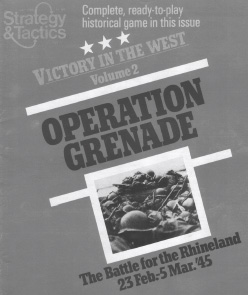 Victory in the West, Volume 2
Victory in the West, Volume 2Operation Grenade
The Battle for the Rhineland
Introduction
Operation Grenade is a simulation of the U.S. Ninth Armyís February 1945 offensive in the Rhineland area of Germany. Each game-turn represents one day of real time and each hex represents approximately 2.4 miles across.Credits
Designer: Joseph M. BalkoskiPublisher: SPI, 1981 (S&T 84)
Components
1 22Ēx34Ē Map
255 die-cut counters
1 Standard 8-page rule folder
1 Exclusive 4-page rule folder
Counter Manifest
USA (black on green)14 Tank Battalions
12 Mechanized Infantry Brigades
4 Reconnaissance Regiments
4 Self-Propelled Artillery brigade
36 Infantry Regiments
14 Artillery brigades
1 Infantry Battalion
Germans (Black on grey)
8 Panzer battalions
8 Mechanized Infantry regiments
6 Infantry regiments
1 Infantry battalions
2 Artillery brigades
8 Volksturm Battalions
Markers (black on white)
1 Game Turn
1 Start Game
1 Mud indicator
10 Destroyed Bridges
8 Out of supply
23 3-Strength Chits
39 2-Strength Chits
25 1-Strength Chits
5 Blank Counters
Playerís Value
Published initially in S&T 84, Operation Grenade is the second volume of the SPI Game System Victory in the West. In February 1945, the Ardennes offensive is over and has failed, the Vaterland has been reached in many places and the German troops are at bay. So itís time for the last big push: to reach and cross the Rhine River, sweeping the last few militia troops in front. Operation Grenade is a small part of a large scale offensive, and musters three US corps to reach the Rhine. Despite Allied intelligence, the Germans are not that weak and even if the offensive was a success, the fight would be hard.The situation is mainly one-sided with some Germans trying to defend the country in front of the Rhineland. They have very few, weak troops against a large mass of US divisions reinforced with tanks and artillery. The Germans will play defensively during the entire game. Hopefully they have good positions: first the Roehr river, which can be flooded in different ways, and behind the river, many lines of entrenchment and improved positions. It is possible to delay and inflict many casualties to the GIís: first during the crossing, and second during the piercing of the entrenchment lines, but ultimately the cleanup of the Rhine land is just a question of time. The fun for the Germans is to blow up the Rhine bridges under the nose of US recce, but itís just a die roll. The specific rules cover weather (a lot of mud), Rhoer flooding specifications, airpower, German Volk sturm militia, and bridge blowing with some US coup de main to prevent it. All in all, the game is interesting to play, changing sides and comparing victory levels. The rules are clean and the game fast.
Collectorís Value
Boone lists low, high and average prices of 2/20/6.20 at auction and 4/16/9.21 for sale. The S&T issue is a good addition for the collector, with historical back ground and other articles.Support Material
Moves 60, pages 10-13, delivers the definitive operational analysis of the game. The Phoenix 35: Jan 1982, pages 9-11 has a good article on the simulation. A capsule review is provided in F&M 65 page 25, part of the large WWII games anthology. For French readers, Casus Belli 13, February 1983, briefly presents the game.Other games of this type
Operation Typhoon; Operation Grenade; and Sicily.Other games by this designer
Operation Typhoon
Reviews
Back to Simulacrum Vol. 4 No. 2 Table of Contents
Back to Simulacrum List of Issues
Back to MagWeb Master Magazine List
© Copyright 2002 by Steambubble Graphics
This article appears in MagWeb (Magazine Web) on the Internet World Wide Web. Other military history articles and gaming articles are available at http://www.magweb.com